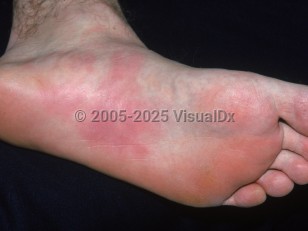Pressure urticaria in Adult
Alerts and Notices
Important News & Links
Synopsis

Pressure urticaria is a type of physical, inducible urticaria characterized by a wheal-and-flare response of the skin to sustained pressure stimuli. Presumably, it occurs by a pressure-related mechanism that results in mast cell degranulation, with release of histamine. This uncommon entity usually affects adults in the second to third decade, with an average disease duration of 3-9 years. Men are affected twice as often as women.
Two forms of pressure urticaria are recognized: immediate pressure urticaria (IPU), also known as dermographism, and delayed pressure urticaria (DPU). In IPU, swelling and erythema of the skin begin within minutes of the offending pressure stimulus, versus DPU, which takes 4-8 hours for a reaction to develop.
Lesions in pressure urticaria may last for 8-72 hours, a range that is much longer than that of most other forms of urticaria.
Common triggers of pressure urticaria include walking (sustained pressure on the feet), manual labor (sustained pressure on the hands), sitting (sustained pressure on the buttocks), laying down (sustained pressure on the back), and tight clothing. Pressure urticaria can be extremely debilitating, and it tends to impact quality of life more significantly than most other forms of chronic urticaria.
Pressure urticaria is associated with other forms of chronic urticaria, and aspirin intolerance. It presents as deep swelling often accompanied by burning, stinging, pain, and dysesthesias at the involved site. Unusual forms may present with only pruritus and/or bullae formation. Systemic symptoms may be present in up to 50% of cases and include fever, chills, joint pain, headache, sweating, and dizziness.
Two forms of pressure urticaria are recognized: immediate pressure urticaria (IPU), also known as dermographism, and delayed pressure urticaria (DPU). In IPU, swelling and erythema of the skin begin within minutes of the offending pressure stimulus, versus DPU, which takes 4-8 hours for a reaction to develop.
Lesions in pressure urticaria may last for 8-72 hours, a range that is much longer than that of most other forms of urticaria.
Common triggers of pressure urticaria include walking (sustained pressure on the feet), manual labor (sustained pressure on the hands), sitting (sustained pressure on the buttocks), laying down (sustained pressure on the back), and tight clothing. Pressure urticaria can be extremely debilitating, and it tends to impact quality of life more significantly than most other forms of chronic urticaria.
Pressure urticaria is associated with other forms of chronic urticaria, and aspirin intolerance. It presents as deep swelling often accompanied by burning, stinging, pain, and dysesthesias at the involved site. Unusual forms may present with only pruritus and/or bullae formation. Systemic symptoms may be present in up to 50% of cases and include fever, chills, joint pain, headache, sweating, and dizziness.
Codes
ICD10CM:
L50.8 – Other urticaria
SNOMEDCT:
387787005 – Pressure urticaria
L50.8 – Other urticaria
SNOMEDCT:
387787005 – Pressure urticaria
Look For
Subscription Required
Diagnostic Pearls
Subscription Required
Differential Diagnosis & Pitfalls

To perform a comparison, select diagnoses from the classic differential
Subscription Required
Best Tests
Subscription Required
Management Pearls
Subscription Required
Therapy
Subscription Required
References
Subscription Required
Last Reviewed:02/21/2022
Last Updated:06/15/2022
Last Updated:06/15/2022
Pressure urticaria in Adult

